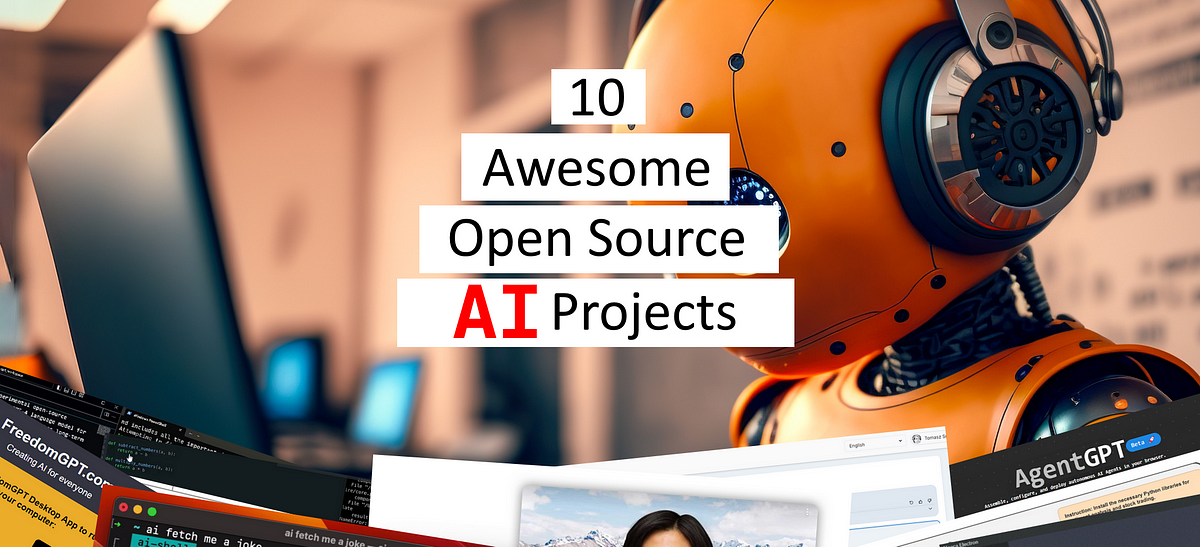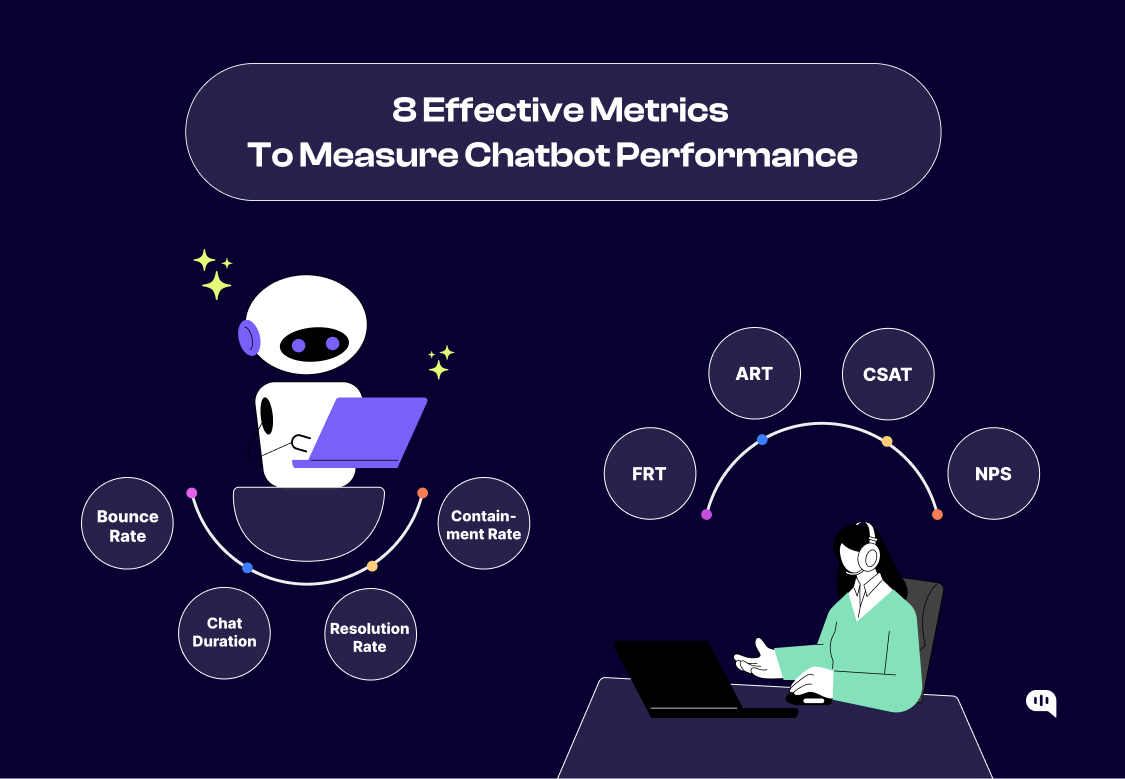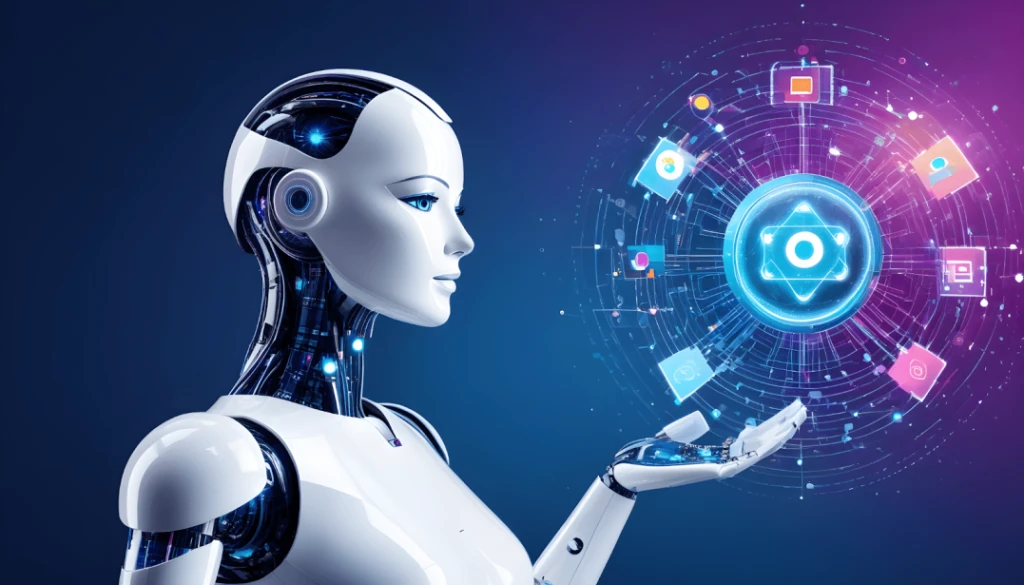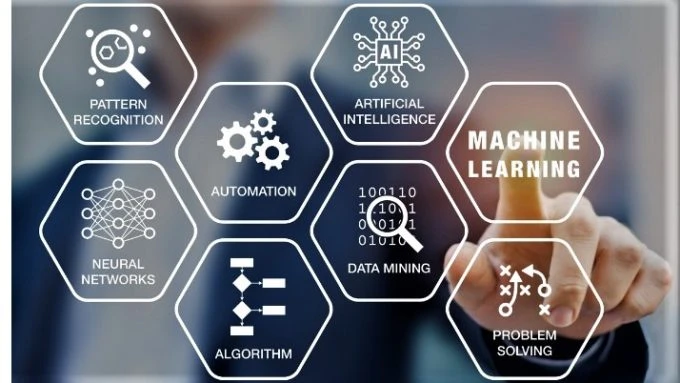IzmááÈiniet MI savá tá¨meká¥a vietná 60 sekundás
Skatiet, ká mé¨su MI acumirklᨠanalizá jé¨su tá¨meká¥a vietni un izveido personalizátu tárzáéÀanas robotu - bez reáÈistrácijas. VienkáréÀi ievadiet savu URL un várojiet, ká tas darbojas!
Ievads: Atvártá pirmkoda AI zelta laikmets
Atvártá pirmkoda AI projekti ir párvártuéÀies no akadámiskám zinátkárám par raéƒoéÀanai gataviem rá¨kiem, kas nodroéÀina lietojumprogrammu darbá¨bu visás nozarás. Viéi ir demokratizájuéÀi pieká¥uvi visprogresá¨vákajám tehnoloáÈijám, iespájojuéÀi pielágoéÀanu, ko patentátás sistámas nevar saskaéot, un radá¨juéÀi dinamiskas kopienas, kas paátrina zináéÀanu apmaiéu un inovácijas.
é ajá rakstá ir apskatá¨ti desmit éÀobrá¨d iespaidá¨gákie atvártá pirmkoda AI projekti. é ie projekti izceá¥as ne tikai ar savám tehniskajám iespájám, bet arᨠar to ietekmi uz plaéÀáku AI ekosistámu, to novatoriskajám pieejám sareéƒáÈá¨tu problámu risináéÀanai un to potenciálu veidot mákslá¨gá intelekta attá¨stá¨bas nákotni.
No lieliem valodu modeá¥iem, kas konkurá ar komerciáliem piedávájumiem, lá¨dz specializátiem rá¨kiem, kas ar ievárojamu efektivitáti risina á¨paéÀas problámas, éÀie projekti ir kopienas virzá¨tas AI attá¨stá¨bas lá¨deri. Neatkará¨gi no tá, vai esat maéÀá¨nmácá¨bas pátnieks, lietojumprogrammu izstrádátájs vai vienkáréÀi interesájas par AI tehnoloáÈiju nákotni, éÀie ir projekti, kurus ir várts skatá¨ties jau tagad.
1. Apskávieni sejas transformatori: atvártá pirmkoda AI centrs
Kápác tas ir revolucionárs
Transformatoru bibliotáka pati par sevi ir pietiekami iespaidá¨ga ã tá nodroéÀina vienotu API darbam ar té¨kstoéÀiem iepriekéÀ apmácá¨tu modeá¥u. Bet tas, kas padara Hugging Face patiesi revolucionáru, ir tá plaéÀáká ekosistáma:
Modeá¥u centrs: ar vairák neká 150ô 000 brá¨vi pieejamiem iepriekéÀ apmácá¨tiem modeá¥iem, centrmezgls ir ká¥uvis par pasaulá lieláko koplietojamo maéÀá¨nmácá¨éÀanás modeá¥u krátuvi, kas aptver valodu, redzájumu, audio un multimodálas lietojumprogrammas.
Datu kopas: té¨kstoéÀiem atlasá¨tu, versijám kontrolátu datu kopu modeá¥u apmácá¨bai un novártáéÀanai, nováréÀot vienu no nozá¨má¨gákajiem mákslá¨gá intelekta attá¨stá¨bas éÀáñáréÀá¥iem.
Spaces: infrastrukté¨ra interaktá¨vu maéÀá¨nmácá¨éÀanás demonstráciju izvietoéÀanai, á¥aujot ikvienam demonstrát strádájoéÀas lietojumprogrammas, kas veidotas uz atvártiem modeá¥iem.
Sadarbá¨bas darbplé¨smas: uz Git balstá¨ta versiju kontrole modeá¥iem un datu kopám, padarot sadarbá¨bu AI projektos tikpat racionalizátu ká programmaté¨ras izstrádi.
Ietekme uz reálo pasauli
Hugging Face ir ká¥uvusi par neskaitámu raéƒoéÀanas AI sistámu mugurkaulu, sákot no jaunizveidotiem uzéámumiem lá¨dz Fortune 500 uzéámumiem. NodroéÀinot visaptveroéÀu infrastrukté¨ru visam maéÀá¨nmácá¨éÀanás dzá¨ves ciklam, tas ir ievárojami samazinájis éÀáñáréÀá¥us uzlaboto AI iespáju ievieéÀanai.
Kopienas aspektu nevar párvártát ã Hugging Face ir radá¨jusi dalá¨éÀanás un sadarbá¨bas kulté¨ru, kas paátrina AI demokratizáciju. Pátnieki var dalá¨ties ar jaunám arhitekté¨rám, praktiáñi var atrast specializátus modeá¥us to izmantoéÀanas gadá¨jumiem, un ikviens gé¨st labumu no kolektá¨vajám zináéÀanám un resursiem.
Hugging Face lá¨dzdibinátájs Déƒé¨ljens é omonds uzsver éÀo kopienas uzmaná¨bu: "Mé¨su misija ir demokratizát labu maéÀá¨nmácá¨bu. Ikviena ieguldá¨jums un savstarpája darba pilnveidoéÀana ir átrákais ceá¥éÀ uz labáku AI."
Ievárojamas funkcijas un iespájas
AutoClass interfeiss: automátiski atlasa optimálo iepriekéÀ sagatavoto modeli konkrátiem uzdevumiem, vienkáréÀojot ievieéÀanu.
Modeá¥u kartes: standartizáta dokumentácija, kas nodroéÀina párskatámá¨bu par modeá¥a iespájám, ierobeéƒojumiem un novirzám.
Optimála bibliotáka: rá¨ki modeá¥a veiktspájas optimizáéÀanai daéƒádás aparaté¨ras platformás.
NovártáéÀanas sistáma: standartizáta salá¨dzinoéÀá novártáéÀana, lai salá¨dzinátu modeá¥a veiktspáju.
Hugging Face Transformers paráda, ká atvártais avots var bé¨tiski párveidot nozari, radot kopá¨gu infrastrukté¨ru, kas sniedz labumu visai AI ekosistámai.
2. LangChain: AI lietojumprogrammu sistámas izveide
Kápác tas ir revolucionárs
LangChain nodroéÀina visaptveroéÀu sistámu lietojumprogrammu izstrádei, ko darbina valodu modeá¥i, nováréÀot kritisko plaisu starp neapstrádátám AI iespájám un noderá¨gám lietojumprogrammám.
Saliekamás áñádes: elastá¨ga arhitekté¨ra vairáku AI iespáju apvienoéÀanai saskaéotás darbplé¨smás.
AáÈenti: autonomu AI sistámu ievieéÀana, kas var pamatot, plánot un izpildá¨t uzdevumus, izsaucot daéƒádus rá¨kus.
Atmiéas sistámas: daéƒádas metodes konteksta uzturáéÀanai sarunás un procesos laika gaitá.
Retrieval-Augmented Generation: rá¨ki valodu modeá¥u iezemáéÀanai konkrátos datu avotos, ievárojami uzlabojot to precizitáti un lietderá¨bu domána specifiskám lietojumprogrammám.
Rá¨ka lietoéÀana: standartizátas saskarnes AI sistámám, lai mijiedarbotos ar árájám lietojumprogrammám, datu bázám un API.
Ietekme uz reálo pasauli
LangChain ir ká¥uvusi par bé¨tisku infrastrukté¨ru té¨kstoéÀiem AI lietojumprogrammu, sákot no klientu apkalpoéÀanas automatizácijas lá¨dz satura áÈeneráéÀanas platformám un beidzot ar specializátiem pátniecá¨bas rá¨kiem. Tá elastá¨gá arhitekté¨ra á¥auj izstrádátájiem átri izveidot prototipus un atkártot sareéƒáÈá¨tas AI lietojumprogrammas, kurám pretájá gadá¨jumá bé¨tu nepiecieéÀami máneéÀi pielágotas izstrádes.
Projekts paráda, ká atvártais avots paátrina inovácijasô ã nodroéÀinot standartizátus komponentus AI lietojumprogrammu izstrádes parastajiem modeá¥iem, LangChain á¥auj izstrádátájiem koncentráties uz unikálu vártá¨bu, nevis uz pamata infrastrukté¨ras atjaunoéÀanu.
Harisons áeiss, LangChain lá¨dzdibinátájs, apraksta éÀo átiku: "Mé¨su máráñis ir padará¨t 10x átráku AI lietojumprogrammu izveidi, kas patieéÀám ir noderá¨gas. Tas nozá¨má visu apkártájo problámu risináéÀanu ã savienojumu ar datu avotiem, konteksta uzturáéÀanu, uzticamu darbplé¨smu izpildi ã ne tikai API izsaukumu veikéÀanu valodu modeá¥iem."
Ievárojamas funkcijas un iespájas
Dokumentu ieládátáji: iepriekéÀ izveidoti savienotáji desmitiem datu avotu, sákot no PDF failiem lá¨dz tá¨meká¥a lapám un beidzot ar datu bázám.
Vektoru veikali: integrácijas ar vektoru datu bázám semantiskás mekláéÀanas iespájám.
Strukturáta izvade: rá¨ki strukturátu datu uzticamai iegé¨éÀanai no nestrukturáta teksta.
NovártáéÀanas ietvars: lietojumprogrammu veiktspájas testáéÀanas un uzlaboéÀanas metodes.
LangChain paráda, ká atvártá pirmkoda projekti var radá¨t pilná¨gi jaunas kategorijas un átri ká¥é¨t par kritisko infrastrukté¨ru jaunajai tehnoloáÈijai.
3. LocalAI: AI ievieéÀana jé¨su aparaté¨rá
Kápác tas ir revolucionárs
LocalAI nodroéÀina pilná¨gu platformu AI modeá¥u lokálai darbináéÀanai ar arhitekté¨ru, kurá prioritáte ir pieejamá¨ba un praktiskums:
API savietojamá¨ba: lokáli ievieéÀ ar OpenAI saderá¨gas API, á¥aujot izstrádátájiem párslágties starp mákoéa izvietoéÀanu un vietájo izvietoéÀanu bez koda izmaiéám.
Modeá¥a zoodárzs: iepriekéÀ konfiguráta pieká¥uve plaéÀam atvárto modeá¥u klástam, sákot no valodu modeá¥iem lá¨dz attálu áÈeneratoriem un beidzot ar audio apstrádi.
Aparaté¨ras optimizácija: automátiska konfigurácija, pamatojoties uz pieejamo aparaté¨ru, á¥aujot modeá¥iem efektá¨vi darboties visás ierá¨cás, sákot no spáá¥u klápjdatoriem lá¨dz specializátám malas ierá¨cám.
KvantáéÀanas atbalsts: iebé¨váti rá¨ki modeá¥u saspieéÀanai, lai tie darbotos ar ierobeéƒotu aparaté¨ru, vienlaikus saglabájot pieéemamu veiktspáju.
Konfidencialitáte pirmajá vietá: pilná¨ga datu suverenitáte bez árájas saziéas, á¥aujot izmantot gadá¨jumus, kad datu konfidencialitáte ir á¥oti svará¨ga.
Ietekme uz reálo pasauli
LocalAI ir iespájojis pilná¨gi jaunas lietojumprogrammu kategorijas, kurás uz mákoéiem balstá¨ta AI bé¨tu nepraktiska, no bezsaistes balss palá¨giem lá¨dz privátuma jutá¨gám medicá¨nas lietojumprogrammám un ré¨pnieciskám sistámám vidás bez uzticama savienojuma.
Izstrádátájiem un organizácijám, kuras ré¨pájas par datu privátumu vai mákoéa izmaksám, LocalAI nodroéÀina praktisku alternatá¨vu, kas saglabá lieláko daá¥u iespáju, vienlaikus nováréÀot éÀá¨s problámas. Tas ir á¨paéÀi vártá¨gs regulátajás nozarás, kur datu párvaldá¨bas prasá¨bas padara mákoéa AI pakalpojumu ievieéÀanu sareéƒáÈá¨tu.
Enriko Bergamini, galvenais LocalAI lá¨dzstrádnieks, uzsver éÀo uzmaná¨bu: "AI jábé¨t pieejamai ikvienam, ne tikai tiem, kam ir milzá¨gs mákoéu budéƒets vai specializáta aparaté¨ra. Más pierádám, ka jé¨s varat darbinát iespaidá¨gas AI iespájas ar jau esoéÀo aparaté¨ru."
Ievárojamas funkcijas un iespájas
Uz konteineriem balstá¨ta izvietoéÀana: vienkáréÀa iestatá¨éÀana, izmantojot Docker konsekventai izvietoéÀanai daéƒádás vidás.
Whisper API: runas párveidoéÀanas iespájas, kas darbojas pilná¨bá lokáli.
Stabila difé¨zijas integrácija: attálu áÈeneráéÀana bez árájiem pakalpojumiem.
Multimodálais atbalsts: teksta, attála, audio un video iespájas vienotá sistámá.
LocalAI paráda, ká atvártais avots var tieéÀi novárst komerciálo pieeju ierobeéƒojumus, radot alternatá¨vas, kas pieéÀáñir prioritáti daéƒádiem kompromisiem un nodroéÀina jaunus lietoéÀanas gadá¨jumus.
4. Ollama: vietájás LLM izvietoéÀanas vienkáréÀoéÀana
Kápác tas ir revolucionárs
Ollama apvieno tehnisko izsmalcinátá¨bu ar izcilu lietojamá¨bu, lai padará¨tu vietájo AI pieejamu:
Vienas rindas instaláéÀana: lai sáktu darbu, nepiecieéÀama tikai viena komanda bez sareéƒáÈá¨tas konfigurácijas vai atkará¨bám.
Modeá¥u bibliotáka: atlasá¨ta optimizátu modeá¥u kolekcija, katram no kuriem ir atéÀáñirá¨gas iespájas un resursu prasá¨bas.
Komandrindas interfeiss: vienkáréÀas, intuitá¨vas komandas modeá¥u lejupieládei un sarunu sákéÀanai.
API serveris: iebé¨váts API galapunkts vietájo modeá¥u integráéÀanai lietojumprogrammás un darbplé¨smás.
Modeá¥u párvaldá¨ba: vienkáréÀi rá¨ki modeá¥u lejupieládei, atjaunináéÀanai un noéeméÀanai.
Ietekme uz reálo pasauli
Ollama ir ievárojami paplaéÀinájusi vietájo AI modeá¥u auditoriju, padarot tos pieejamus izstrádátájiem, pátniekiem un entuziastiem, kurus citádi varátu atturát tehniská sareéƒáÈá¨tá¨ba. Tas ir paátrinájis eksperimentáéÀanu un pieéeméÀanu daudzás jomás.
Lietotájiem un organizácijám, kas apzinás privátumu, Ollama nodroéÀina praktisku veidu, ká izpátá¨t modernás AI iespájas, nenosé¨tot sensitá¨vus datus árájiem pakalpojumiem. Tá vienkáréÀá¨ba ir padará¨jusi to á¨paéÀi populáru izglá¨tá¨bas iestádás, kur tá nodroéÀina praktisku mácá¨éÀanos, neprasot mákoékontus vai specializátu aparaté¨ru.
Mets é ulte, Ollama lá¨dzstrádnieks, skaidro éÀo fokusu: "Más válájámies, lai vietájá LLM palaiéÀana bé¨tu tikpat vienkáréÀa ká jebkuras citas lietojumprogrammas instaláéÀana. TehnoloáÈija ir sareéƒáÈá¨ta, taáu to nevajadzátu izmantot."
Ievárojamas funkcijas un iespájas
Modeá¥a pielágoéÀana: rá¨ki modeá¥u specializátu versiju izveidei ar pielágotiem parametriem.
Sarunas konteksta párvaldá¨ba: uztur kontekstu starp vaicájumiem dabiskai mijiedarbá¨bai.
GPU paátrinájums: automátiska pieejamo GPU resursu izmantoéÀana uzlabotai veiktspájai.
Multimodáls atbalsts: ne tikai tekstu, bet arᨠattálus un citus datu veidus.
Ollama ilustrá principu, ka patiesi transformájoéÀa tehnoloáÈija ká¥é¨st neredzama ã liekot modernákajám AI iespájám justies ká jebkuram citam datora rá¨kam.
IzmááÈiniet MI savá tá¨meká¥a vietná 60 sekundás
Skatiet, ká mé¨su MI acumirklᨠanalizá jé¨su tá¨meká¥a vietni un izveido personalizátu tárzáéÀanas robotu - bez reáÈistrácijas. VienkáréÀi ievadiet savu URL un várojiet, ká tas darbojas!
5. Mistral AI: jaunu standartu noteikéÀana atvártiem modeá¥iem
Meta Description: Discover the most groundbreaking open source AI projects that are pushing boundaries, democratizing advanced technology, and creating new possibilities for developers worldwide.
Introduction: The Golden Age of Open Source AI
We're living in an unprecedented era for artificial intelligence development. While commercial AI solutions continue to make headlines, the open source community has become an extraordinary force driving innovation, accessibility, and transparency in AI technology. These community-driven projects are not just alternatives to proprietary systemsãin many cases, they're pushing the boundaries of what's possible and setting new standards for the entire industry.
Open source AI projects have transformed from academic curiosities into production-ready tools powering applications across industries. They've democratized access to cutting-edge technology, enabled customization that proprietary systems can't match, and created vibrant communities that accelerate knowledge sharing and innovation.
This article explores ten of the most impressive open source AI projects right now. These projects stand out not just for their technical capabilities but for their impact on the broader AI ecosystem, their innovative approaches to solving complex problems, and their potential to shape the future of artificial intelligence development.
From large language models rivaling commercial offerings to specialized tools solving specific problems with remarkable efficiency, these projects represent the cutting edge of community-driven AI development. Whether you're a machine learning researcher, an application developer, or simply interested in the future of AI technology, these are the projects worth watching right now.
1. Hugging Face Transformers: The Open Source AI Hub
Hugging Face Transformers has evolved from a simple NLP library into what many consider the GitHub for machine learningãa comprehensive ecosystem that's fundamentally changing how AI models are developed, shared, and deployed.
Why It's Groundbreaking
The Transformers library itself is impressive enoughãproviding a unified API for working with thousands of pre-trained models. But what makes Hugging Face truly revolutionary is its broader ecosystem:
Model Hub: With over 150,000 freely available pre-trained models, the Hub has become the world's largest repository of shared machine learning models, spanning language, vision, audio, and multimodal applications.
Datasets: Thousands of curated, version-controlled datasets for training and evaluating models, addressing one of the most significant barriers to AI development.
Spaces: An infrastructure for deploying interactive machine learning demos, enabling anyone to showcase working applications built on open models.
Collaborative Workflows: Git-based version control for models and datasets, making collaboration on AI projects as streamlined as software development.
Real-World Impact
Hugging Face has become the backbone of countless production AI systems, from startups to Fortune 500 companies. By providing a comprehensive infrastructure for the entire machine learning lifecycle, it has dramatically reduced the barriers to implementing advanced AI capabilities.
The community aspect cannot be overstatedãHugging Face has created a culture of sharing and collaboration that's accelerating the democratization of AI. Researchers can share new architectures, practitioners can find specialized models for their use cases, and everyone benefits from the collective knowledge and resources.
Julien Chaumond, co-founder of Hugging Face, emphasizes this community focus: "Our mission is to democratize good machine learning. Having everyone contribute and build on each other's work is the fastest path to better AI."
Notable Features and Capabilities
AutoClass Interface: Automatically selects the optimal pre-trained model for specific tasks, simplifying implementation.
Model Cards: Standardized documentation that provides transparency about model capabilities, limitations, and biases.
Optimum Library: Tools for optimizing model performance across different hardware platforms.
Evaluation Harness: Standardized benchmarking to compare model performance.
Hugging Face Transformers exemplifies how open source can fundamentally transform an industry, creating a shared infrastructure that benefits the entire AI ecosystem.
2. LangChain: Building the Framework for AI Applications
LangChain emerged to solve a critical problem: while foundation models provide impressive capabilities, building practical applications with them requires significant additional infrastructure. In just over a year, it has become the de facto standard for developing LLM-powered applications.
Why It's Groundbreaking
LangChain provides a comprehensive framework for developing applications powered by language models, addressing the critical gap between raw AI capabilities and useful applications:
Composable Chains: A flexible architecture for combining multiple AI capabilities into coherent workflows.
Agents: Implementation of autonomous AI systems that can reason, plan, and execute tasks by calling different tools.
Memory Systems: Various methods for maintaining context in conversations and processes over time.
Retrieval-Augmented Generation: Tools for grounding language models in specific data sources, dramatically improving their accuracy and usefulness for domain-specific applications.
Tool Usage: Standardized interfaces for AI systems to interact with external applications, databases, and APIs.
Real-World Impact
LangChain has become essential infrastructure for thousands of AI applications, from customer service automation to content generation platforms to specialized research tools. Its flexible architecture allows developers to rapidly prototype and iterate on complex AI applications that would otherwise require months of custom development.
The project exemplifies how open source accelerates innovationãby providing standardized components for common patterns in AI application development, LangChain lets developers focus on unique value rather than rebuilding basic infrastructure.
Harrison Chase, co-founder of LangChain, describes this ethos: "Our goal is to make it 10x faster to build AI applications that are actually useful. That means solving all the surrounding problemsãconnecting to data sources, maintaining context, executing reliable workflowsãnot just making API calls to language models."
Notable Features and Capabilities
Document Loaders: Pre-built connectors for dozens of data sources, from PDFs to web pages to databases.
Vector Stores: Integrations with vector databases for semantic search capabilities.
Structured Output: Tools for reliably extracting structured data from unstructured text.
Evaluation Framework: Methods for testing and improving application performance.
LangChain demonstrates how open source projects can create entirely new categories and rapidly become critical infrastructure for an emerging technology.
3. LocalAI: Bringing AI to Your Hardware
LocalAI represents a powerful movement in AI developmentãbringing sophisticated models to local hardware without requiring cloud services or expensive specialized equipment.
Why It's Groundbreaking
LocalAI provides a complete platform for running AI models locally, with an architecture that prioritizes accessibility and practicality:
API Compatibility: Implements OpenAI-compatible APIs locally, allowing developers to switch between cloud and local deployment without code changes.
Model Zoo: Pre-configured access to a wide range of open models, from language models to image generators to audio processing.
Hardware Optimization: Automatic configuration based on available hardware, making models run efficiently on everything from gaming laptops to specialized edge devices.
Quantization Support: Built-in tools for compressing models to run on limited hardware while maintaining acceptable performance.
Privacy-First Design: Complete data sovereignty with no external communication, enabling use cases where data privacy is critical.
Real-World Impact
LocalAI has enabled entirely new categories of applications where cloud-based AI would be impractical, from offline voice assistants to privacy-sensitive medical applications to industrial systems in environments without reliable connectivity.
For developers and organizations concerned about data privacy or cloud costs, LocalAI provides a practical alternative that maintains most capabilities while addressing these concerns. It's particularly valuable in regulated industries where data governance requirements make cloud AI services challenging to implement.
Enrico Bergamini, a key contributor to LocalAI, highlights this focus: "AI should be accessible to everyone, not just those with massive cloud budgets or specialized hardware. We're proving that you can run impressive AI capabilities on the hardware you already have."
Notable Features and Capabilities
Container-Based Deployment: Simple setup using Docker for consistent deployment across environments.
Whisper API: Speech-to-text capabilities that run entirely locally.
Stable Diffusion Integration: Image generation without external services.
Multi-Modal Support: Text, image, audio, and video capabilities in a unified system.
LocalAI demonstrates how open source can directly address limitations of commercial approaches, creating alternatives that prioritize different trade-offs and enable new use cases.
4. Ollama: Simplifying Local LLM Deployment
While various projects focus on running large language models locally, Ollama stands out for making the process remarkably straightforward even for non-technical users.
Why It's Groundbreaking
Ollama combines technical sophistication with exceptional usability to make local AI accessible:
One-Line Installation: Getting started requires just a single command, with no complex configuration or dependencies.
Model Library: A curated collection of optimized models, each with different capability and resource requirement trade-offs.
Command-Line Interface: Simple, intuitive commands for downloading models and starting conversations.
API Server: Built-in API endpoint for integrating local models into applications and workflows.
Model Management: Straightforward tools for downloading, updating, and removing models.
Real-World Impact
Ollama has dramatically expanded the audience for local AI models, making them accessible to developers, researchers, and enthusiasts who might otherwise have been deterred by technical complexity. This has accelerated experimentation and adoption across numerous domains.
For privacy-conscious users and organizations, Ollama provides a practical way to explore modern AI capabilities without sending sensitive data to external services. Its simplicity has made it particularly popular in educational settings, where it enables hands-on learning without requiring cloud accounts or specialized hardware.
Matt Schulte, Ollama contributor, explains this focus: "We wanted to make running a local LLM as simple as installing any other application. The technology is complex, but using it shouldn't be."
Notable Features and Capabilities
Model Customization: Tools for creating specialized versions of models with custom parameters.
Conversation Context Management: Maintains context between queries for natural interactions.
GPU Acceleration: Automatic utilization of available GPU resources for improved performance.
Multimodal Support: Expanding beyond text to handle images and other data types.
Ollama exemplifies the principle that truly transformative technology becomes invisibleãmaking cutting-edge AI capabilities feel like any other tool on your computer.
5. Mistral AI: Setting New Standards for Open Models
Mistral AI burst onto the scene with models that challenge the conventional wisdom about the relationship between model size and capability, demonstrating that thoughtful architecture and training approaches can create remarkably powerful open models.
Why It's Groundbreaking
Mistral's approach combines architectural innovation with a commitment to open release:
Efficiency-First Design: Models that achieve remarkable performance with significantly fewer parameters than competitors.
Specialized Instruct Models: Versions specifically tuned for following instructions accurately, rivaling much larger closed-source models.
Sparse Mixture of Experts: Advanced architectures that dynamically activate different parts of the model based on input, dramatically improving efficiency.
Permissive Licensing: Models released under Apache 2.0, allowing both research and commercial applications without restrictions.
Multimodal Capabilities: Expanding beyond text to handle images and structured data inputs.
Real-World Impact
Mistral's models have enabled numerous applications and services that would otherwise have required proprietary models with restrictive licensing and higher resource requirements. Their combination of performance and efficiency has made sophisticated AI capabilities accessible to organizations with limited computational resources.
The permissive licensing and open weights have facilitated extensive research and customization, with hundreds of specialized adaptations created by the community for specific domains and languages. This has particularly benefited languages and use cases that receive less attention from commercial providers.
Arthur Mensch, CEO of Mistral AI, emphasizes this approach: "We believe in creating technology that's both state-of-the-art and genuinely open. Our models aren't just open in nameãthey're designed to be studied, modified, and deployed without restrictions."
Notable Features and Capabilities
Context Length Scaling: Models that efficiently handle very long contexts without performance degradation.
Code Generation: Strong capabilities for programming tasks across multiple languages.
Reasoning Abilities: Sophisticated logical reasoning comparable to much larger models.
Multi-Language Support: Strong performance across numerous languages beyond English.
Mistral demonstrates how open source innovation can challenge dominant commercial approaches, creating alternatives that prioritize different values and performance characteristics.
6. GGUF ekosistáma: demokratizájoéÀá modeá¥a ievieéÀana
Meta Description: Discover the most groundbreaking open source AI projects that are pushing boundaries, democratizing advanced technology, and creating new possibilities for developers worldwide.
Introduction: The Golden Age of Open Source AI
We're living in an unprecedented era for artificial intelligence development. While commercial AI solutions continue to make headlines, the open source community has become an extraordinary force driving innovation, accessibility, and transparency in AI technology. These community-driven projects are not just alternatives to proprietary systemsãin many cases, they're pushing the boundaries of what's possible and setting new standards for the entire industry.
Open source AI projects have transformed from academic curiosities into production-ready tools powering applications across industries. They've democratized access to cutting-edge technology, enabled customization that proprietary systems can't match, and created vibrant communities that accelerate knowledge sharing and innovation.
This article explores ten of the most impressive open source AI projects right now. These projects stand out not just for their technical capabilities but for their impact on the broader AI ecosystem, their innovative approaches to solving complex problems, and their potential to shape the future of artificial intelligence development.
From large language models rivaling commercial offerings to specialized tools solving specific problems with remarkable efficiency, these projects represent the cutting edge of community-driven AI development. Whether you're a machine learning researcher, an application developer, or simply interested in the future of AI technology, these are the projects worth watching right now.
1. Hugging Face Transformers: The Open Source AI Hub
Hugging Face Transformers has evolved from a simple NLP library into what many consider the GitHub for machine learningãa comprehensive ecosystem that's fundamentally changing how AI models are developed, shared, and deployed.
Why It's Groundbreaking
The Transformers library itself is impressive enoughãproviding a unified API for working with thousands of pre-trained models. But what makes Hugging Face truly revolutionary is its broader ecosystem:
Model Hub: With over 150,000 freely available pre-trained models, the Hub has become the world's largest repository of shared machine learning models, spanning language, vision, audio, and multimodal applications.
Datasets: Thousands of curated, version-controlled datasets for training and evaluating models, addressing one of the most significant barriers to AI development.
Spaces: An infrastructure for deploying interactive machine learning demos, enabling anyone to showcase working applications built on open models.
Collaborative Workflows: Git-based version control for models and datasets, making collaboration on AI projects as streamlined as software development.
Real-World Impact
Hugging Face has become the backbone of countless production AI systems, from startups to Fortune 500 companies. By providing a comprehensive infrastructure for the entire machine learning lifecycle, it has dramatically reduced the barriers to implementing advanced AI capabilities.
The community aspect cannot be overstatedãHugging Face has created a culture of sharing and collaboration that's accelerating the democratization of AI. Researchers can share new architectures, practitioners can find specialized models for their use cases, and everyone benefits from the collective knowledge and resources.
Julien Chaumond, co-founder of Hugging Face, emphasizes this community focus: "Our mission is to democratize good machine learning. Having everyone contribute and build on each other's work is the fastest path to better AI."
Notable Features and Capabilities
AutoClass Interface: Automatically selects the optimal pre-trained model for specific tasks, simplifying implementation.
Model Cards: Standardized documentation that provides transparency about model capabilities, limitations, and biases.
Optimum Library: Tools for optimizing model performance across different hardware platforms.
Evaluation Harness: Standardized benchmarking to compare model performance.
Hugging Face Transformers exemplifies how open source can fundamentally transform an industry, creating a shared infrastructure that benefits the entire AI ecosystem.
2. LangChain: Building the Framework for AI Applications
LangChain emerged to solve a critical problem: while foundation models provide impressive capabilities, building practical applications with them requires significant additional infrastructure. In just over a year, it has become the de facto standard for developing LLM-powered applications.
Why It's Groundbreaking
LangChain provides a comprehensive framework for developing applications powered by language models, addressing the critical gap between raw AI capabilities and useful applications:
Composable Chains: A flexible architecture for combining multiple AI capabilities into coherent workflows.
Agents: Implementation of autonomous AI systems that can reason, plan, and execute tasks by calling different tools.
Memory Systems: Various methods for maintaining context in conversations and processes over time.
Retrieval-Augmented Generation: Tools for grounding language models in specific data sources, dramatically improving their accuracy and usefulness for domain-specific applications.
Tool Usage: Standardized interfaces for AI systems to interact with external applications, databases, and APIs.
Real-World Impact
LangChain has become essential infrastructure for thousands of AI applications, from customer service automation to content generation platforms to specialized research tools. Its flexible architecture allows developers to rapidly prototype and iterate on complex AI applications that would otherwise require months of custom development.
The project exemplifies how open source accelerates innovationãby providing standardized components for common patterns in AI application development, LangChain lets developers focus on unique value rather than rebuilding basic infrastructure.
Harrison Chase, co-founder of LangChain, describes this ethos: "Our goal is to make it 10x faster to build AI applications that are actually useful. That means solving all the surrounding problemsãconnecting to data sources, maintaining context, executing reliable workflowsãnot just making API calls to language models."
Notable Features and Capabilities
Document Loaders: Pre-built connectors for dozens of data sources, from PDFs to web pages to databases.
Vector Stores: Integrations with vector databases for semantic search capabilities.
Structured Output: Tools for reliably extracting structured data from unstructured text.
Evaluation Framework: Methods for testing and improving application performance.
LangChain demonstrates how open source projects can create entirely new categories and rapidly become critical infrastructure for an emerging technology.
3. LocalAI: Bringing AI to Your Hardware
LocalAI represents a powerful movement in AI developmentãbringing sophisticated models to local hardware without requiring cloud services or expensive specialized equipment.
Why It's Groundbreaking
LocalAI provides a complete platform for running AI models locally, with an architecture that prioritizes accessibility and practicality:
API Compatibility: Implements OpenAI-compatible APIs locally, allowing developers to switch between cloud and local deployment without code changes.
Model Zoo: Pre-configured access to a wide range of open models, from language models to image generators to audio processing.
Hardware Optimization: Automatic configuration based on available hardware, making models run efficiently on everything from gaming laptops to specialized edge devices.
Quantization Support: Built-in tools for compressing models to run on limited hardware while maintaining acceptable performance.
Privacy-First Design: Complete data sovereignty with no external communication, enabling use cases where data privacy is critical.
Real-World Impact
LocalAI has enabled entirely new categories of applications where cloud-based AI would be impractical, from offline voice assistants to privacy-sensitive medical applications to industrial systems in environments without reliable connectivity.
For developers and organizations concerned about data privacy or cloud costs, LocalAI provides a practical alternative that maintains most capabilities while addressing these concerns. It's particularly valuable in regulated industries where data governance requirements make cloud AI services challenging to implement.
Enrico Bergamini, a key contributor to LocalAI, highlights this focus: "AI should be accessible to everyone, not just those with massive cloud budgets or specialized hardware. We're proving that you can run impressive AI capabilities on the hardware you already have."
Notable Features and Capabilities
Container-Based Deployment: Simple setup using Docker for consistent deployment across environments.
Whisper API: Speech-to-text capabilities that run entirely locally.
Stable Diffusion Integration: Image generation without external services.
Multi-Modal Support: Text, image, audio, and video capabilities in a unified system.
LocalAI demonstrates how open source can directly address limitations of commercial approaches, creating alternatives that prioritize different trade-offs and enable new use cases.
4. Ollama: Simplifying Local LLM Deployment
While various projects focus on running large language models locally, Ollama stands out for making the process remarkably straightforward even for non-technical users.
Why It's Groundbreaking
Ollama combines technical sophistication with exceptional usability to make local AI accessible:
One-Line Installation: Getting started requires just a single command, with no complex configuration or dependencies.
Model Library: A curated collection of optimized models, each with different capability and resource requirement trade-offs.
Command-Line Interface: Simple, intuitive commands for downloading models and starting conversations.
API Server: Built-in API endpoint for integrating local models into applications and workflows.
Model Management: Straightforward tools for downloading, updating, and removing models.
Real-World Impact
Ollama has dramatically expanded the audience for local AI models, making them accessible to developers, researchers, and enthusiasts who might otherwise have been deterred by technical complexity. This has accelerated experimentation and adoption across numerous domains.
For privacy-conscious users and organizations, Ollama provides a practical way to explore modern AI capabilities without sending sensitive data to external services. Its simplicity has made it particularly popular in educational settings, where it enables hands-on learning without requiring cloud accounts or specialized hardware.
Matt Schulte, Ollama contributor, explains this focus: "We wanted to make running a local LLM as simple as installing any other application. The technology is complex, but using it shouldn't be."
Notable Features and Capabilities
Model Customization: Tools for creating specialized versions of models with custom parameters.
Conversation Context Management: Maintains context between queries for natural interactions.
GPU Acceleration: Automatic utilization of available GPU resources for improved performance.
Multimodal Support: Expanding beyond text to handle images and other data types.
Ollama exemplifies the principle that truly transformative technology becomes invisibleãmaking cutting-edge AI capabilities feel like any other tool on your computer.
5. Mistral AI: Setting New Standards for Open Models
Mistral AI burst onto the scene with models that challenge the conventional wisdom about the relationship between model size and capability, demonstrating that thoughtful architecture and training approaches can create remarkably powerful open models.
Why It's Groundbreaking
Mistral's approach combines architectural innovation with a commitment to open release:
Efficiency-First Design: Models that achieve remarkable performance with significantly fewer parameters than competitors.
Specialized Instruct Models: Versions specifically tuned for following instructions accurately, rivaling much larger closed-source models.
Sparse Mixture of Experts: Advanced architectures that dynamically activate different parts of the model based on input, dramatically improving efficiency.
Permissive Licensing: Models released under Apache 2.0, allowing both research and commercial applications without restrictions.
Multimodal Capabilities: Expanding beyond text to handle images and structured data inputs.
Real-World Impact
Mistral's models have enabled numerous applications and services that would otherwise have required proprietary models with restrictive licensing and higher resource requirements. Their combination of performance and efficiency has made sophisticated AI capabilities accessible to organizations with limited computational resources.
The permissive licensing and open weights have facilitated extensive research and customization, with hundreds of specialized adaptations created by the community for specific domains and languages. This has particularly benefited languages and use cases that receive less attention from commercial providers.
Arthur Mensch, CEO of Mistral AI, emphasizes this approach: "We believe in creating technology that's both state-of-the-art and genuinely open. Our models aren't just open in nameãthey're designed to be studied, modified, and deployed without restrictions."
Notable Features and Capabilities
Context Length Scaling: Models that efficiently handle very long contexts without performance degradation.
Code Generation: Strong capabilities for programming tasks across multiple languages.
Reasoning Abilities: Sophisticated logical reasoning comparable to much larger models.
Multi-Language Support: Strong performance across numerous languages beyond English.
Mistral demonstrates how open source innovation can challenge dominant commercial approaches, creating alternatives that prioritize different values and performance characteristics.
6. GGUF Ecosystem: Democratizing Model Deployment
The GGUF (GPT-Generated Unified Format) ecosystem has emerged as a critical infrastructure for making large language models practically deployable across a wide range of hardware.
Why It's Groundbreaking
The GGUF ecosystem addresses the practical challenges of running sophisticated models on available hardware:
Model Quantization: Techniques for compressing models to a fraction of their original size while maintaining acceptable performance.
Format Standardization: A common format enabling interoperability between different frameworks and tools.
Hardware Optimization: Automatic adaptation to available computing resources, from high-end GPUs to basic CPUs.
Inference Engines: Highly optimized runtime environments for model execution.
Community Collaboration: A vibrant ecosystem of tools and resources created by contributors worldwide.
Real-World Impact
GGUF has enabled AI capabilities in contexts where they would otherwise be impossible, from offline deployments to resource-constrained environments to air-gapped systems. This has dramatically expanded the reach of AI technology beyond well-resourced cloud environments.
For developers, the ecosystem provides practical options for deploying models without excessive infrastructure costs. For end-users, it enables applications that work without internet connectivity or with strict privacy requirements. This has been particularly valuable in fields like healthcare, where data privacy concerns often limit cloud AI adoption.
Georgi Gerganov, a key contributor to the ecosystem, notes: "Making these models run efficiently on commodity hardware isn't just an engineering challengeãit's about ensuring AI technology is accessible to everyone, not just those with access to data centers."
Notable Features and Capabilities
llama.cpp: Ultra-efficient inference engine for running LLMs on various hardware.
Compatibility Layers: Tools for converting between different model formats.
Automatic Mixed Precision: Dynamic adjustment of calculation precision for optimal performance.
Server Implementations: Ready-to-use servers for exposing models through standardized APIs.
The GGUF ecosystem demonstrates how focused open source efforts can solve practical problems that might be overlooked by larger commercial projects focused on pushing theoretical capabilities.
7. áuksti: audio barjeru nojaukéÀana
Kápác tas ir revolucionárs
Whisper ir bé¨tisks sasniegums runas atpazá¨éÀanas tehnoloáÈijá:
Daudzvalodu iespájas: spácá¨ga veiktspája 99 valodás bez valodas apmácá¨bas.
Izturá¨ba: izcila veiktspája trokéÀéainos, reálos apstáká¥os, kur daudzám runas atpazá¨éÀanas sistámám ir gré¨tá¨bas.
Zero-Shot Translation: iespája tulkot runu tieéÀi no vienas valodas angá¥u valodá bez á¨paéÀas tulkoéÀanas apmácá¨bas.
Atvártie svari un ievieéÀana: Pilná¨gi modeá¥a svari un kods, kas izdots saskaéá ar atá¥auto MIT licenci.
Saprátá¨gas resursu prasá¨bas: spáj efektá¨vi darboties ar nelielu aparaté¨ru, á¨paéÀi ar kopienas optimizáciju.
Ietekme uz reálo pasauli
Whisper ir iespájojis virkni lietojumprogrammu, padarot audio saturu pieejamáku, sákot no apládes transkripcijas rá¨kiem lá¨dz reállaika subtitru sistámám un beidzot ar valodu apguves lietojumprogrammám. Tá daudzvalodu iespájas ir bijuéÀas á¨paéÀi vártá¨gas nepietiekami apkalpotám valodám, kurám iepriekéÀ tré¨ka praktisku runas atpazá¨éÀanas iespáju.
Pátniekiem un izstrádátájiem Whisper nodroéÀina stabilu pamatu runas iespájotu lietojumprogrammu izveidei, neprasot á¨paéÀas zináéÀanas audio apstrádá vai pieká¥uvi masveida apmácá¨bu datu kopám. Tas ir paátrinájis jauninájumus balss saskarnás un audio analá¨zá daudzás jomás.
Alecs Radfords, viens no Whisper radá¨tájiem, skaidro: "Izmantojot atvártá avota Whisper, mé¨su máráñis bija padará¨t spácá¨gu runas atpazá¨éÀanu pieejamu ká pamatu ikvienam, kas rada tehnoloáÈiju. Sabiedrá¨ba ir izmantojusi éÀo pamatu un izveidojusi neticamu lietojumprogrammu klástu, ko más nekad nebijám paredzájuéÀi."
Ievárojamas funkcijas un iespájas
Laika zá¨moga prognozáéÀana: precá¨za várda lá¨meéa laika informácija, lai sinhronizátu transkriptus ar audio.
Runátáju diarizácija: kopienas paplaéÀinájumi daéƒádu runátáju identificáéÀanai sarunás.
Optimizátas ievieéÀanas: kopienas izstrádátas versijas, kas optimizátas daéƒádiem izvietoéÀanas scenárijiem.
Precá¨zákas reguláéÀanas rá¨ki: metodes modeá¥a pielágoéÀanai noteiktiem domániem vai akcentiem.
Whisper paráda, ká revolucionáro sistámu atklátá pirmkoda izlaidumi var átri paátrinát inováciju visá jomá.
8. Stabilitáte AI atvártie modeá¥i: vizuálás radá¨éÀanas párdomáéÀana
Kápác tas ir revolucionárs
Stabilitátes pieeja apvieno tehniskos jauninájumus ar principiálu atvártu izlaiéÀanu:
Stabila difé¨zija: atvártu attálu áÈeneráéÀanas modeá¥u saime, kas efektá¨vi darbojas ar patárátáju aparaté¨ru.
Specializáti modeá¥i: dománam specifiski modeá¥i tádám jomám ká 3D áÈeneráéÀana, animácija un augstas izéÀáñirtspájas attáli.
Atá¥aujoéÀá licencáéÀana: modeá¥i, kas izlaisti saskaéá ar Creative ML OpenRAIL-M licenci, kas á¥auj izmantot gan pátniecá¨bá, gan komerciáli.
IzvietoéÀanai draudzá¨gs dizains: arhitekté¨ra, kas izstrádáta tá, lai tá bé¨tu praktiska lietoéÀanai reálajá pasaulá, ne tikai pátniecá¨bas demonstrácijás.
Kopienas lá¨dzizstráde: aktá¨va sadarbá¨ba ar plaéÀáku AI kopienu modeá¥u uzlabojumu un lietojumprogrammu jomá.
Ietekme uz reálo pasauli
Stabilitátes atvártie modeá¥i ir nodroéÀinájuéÀi radoéÀuma un lietojumprogrammu izstrádes eksploziju, kas slágtos licencáéÀanas reéƒá¨mos nebé¨tu bijis iespájams. No mákslas áÈeneráéÀanas platformám lá¨dz dizaina rá¨kiem lá¨dz mediju raéƒoéÀanas darbplé¨smám, éÀie modeá¥i ir integráti té¨kstoéÀiem lietojumprogrammu, kas apkalpo miljoniem lietotáju.
Radá¨tájiem modeá¥i nodroéÀina jaunus vizuálás izteiksmes rá¨kus, neprasot máksliniecisku apmácá¨bu. Izstrádátájiem tie piedává celtniecá¨bas blokus specializátu lietojumprogrammu izveidei bez slágto API ierobeéƒojumiem un izmaksám. Tas ir bijis á¨paéÀi vártá¨gs maziem uzéámumiem un atseviéÀáñiem satura veidotájiem, kuri citádi varátu nevarátu pieká¥é¨t éÀádai tehnoloáÈijai.
Emad Mostaque, Stabilitátes AI dibinátájs, uzsver éÀo filozofiju: "Más ticam atvártiem modeá¥iem, jo tie nodroéÀina jauninájumus, ko más nevaram paredzát. Ja jé¨s bloáñájat tehnoloáÈiju aiz API, jé¨s ierobeéƒojat to, ko cilváki var izveidot lá¨dz tam, ko jé¨s paredzat, ka viéiem tas ir nepiecieéÀams."
Ievárojamas funkcijas un iespájas
ControlNet paplaéÀinájumi: precá¨za attálu áÈeneráéÀanas kontrole, izmantojot atsauces attálus vai skices.
SDXL modeá¥i: augstas izéÀáñirtspájas attálu áÈeneráéÀana ar uzlabotu kvalitáti un detaá¥ám.
Konsekvences modeá¥i: átráka áÈeneráéÀana, izmantojot novatoriskas difé¨zijas metodes.
Specializáti pielágojumi: kopienas radá¨ti varianti konkrátiem mákslas stiliem un jomám.
Stabilitátes mákslá¨gá intelekta atvártá pieeja paráda, ká demokratizájot pieká¥uvi progresá¨vám tehnoloáÈijám, var atraisá¨t radoéÀumu un inovácijas globálá márogá.
9. ImageBind: Multimodálás izpratnes savienoéÀana
Why It's Groundbreaking
ImageBind addresses the fundamental challenge of creating unified representations across modalities:
Unified Embedding Space: Creates consistent representations across six modalitiesãimages, text, audio, depth, thermal, and IMU data.
Zero-Shot Transfer: Capabilities learned in one modality transfer to others without explicit training.
Emergent Capabilities: Demonstrates capabilities not explicitly trained for, like audio-to-image retrieval.
Efficient Architecture: Designed for practical deployment rather than just research demonstration.
Compositional Understanding: Ability to understand relationships between different modalities in a unified framework.
Real-World Impact
ImageBind has enabled new classes of applications that understand correlations between different types of data, from more natural multimodal search engines to systems that can generate appropriate audio for images or create visualizations from sound.
For researchers, the project provides new ways to investigate how different modalities relate to one another. For developers, it offers practical tools for building systems that can work with multiple types of input and output in a coherent way. This has been particularly valuable for accessibility applications that need to translate between modalities.
Christopher Pal, a researcher in multimodal AI, notes: "ImageBind represents a fundamental advance in how AI systems understand different types of data. By creating a unified representation space, it enables connections between modalities that previously required specific training for each relationship."
Notable Features and Capabilities
Cross-Modal Retrieval: Find related content across different data types.
Unified Embeddings: Represent diverse data in a consistent mathematical space.
Flexible Integration: Architecture designed to work with existing systems.
Compositional Generation: Create content in one modality based on input from another.
ImageBind demonstrates how open source can accelerate research in emerging areas by providing building blocks for the community to explore new possibilities.
10. XTuner: Democratizing Model Customization
XTuner has emerged as a leading solution for fine-tuning large language models, making model customization accessible to a much wider audience of developers and organizations.
Why It's Groundbreaking
XTuner addresses the critical challenge of adapting foundation models to specific needs:
Resource Efficiency: Makes fine-tuning possible on consumer hardware through optimized training techniques.
Unified Framework: Supports multiple model architectures and fine-tuning methods in a consistent interface.
Parameter-Efficient Methods: Implements techniques like LoRA and QLoRA that update only a small fraction of model parameters.
Reproducible Workflows: Structured approach to creating, managing, and deploying fine-tuned models.
Evaluation Framework: Built-in tools for assessing model performance and improvements.
Real-World Impact
XTuner has enabled thousands of organizations to create customized AI models tailored to their specific domains, terminology, and use cases. This has been particularly valuable for specialized industries and applications where general models lack the necessary domain knowledge or terminology.
For developers without extensive machine learning expertise, XTuner provides accessible tools for adapting advanced models to specific requirements. For smaller organizations, it offers a path to customized AI capabilities without the computational resources typically required for full model training.
Li Yuanqing, an XTuner contributor, explains: "Fine-tuning is where theory meets practice for most AI applications. By making this process more accessible, we're helping organizations create models that actually understand their specific domains and problems."
Notable Features and Capabilities
Adapter Management: Tools for creating, storing, and switching between different fine-tuned adaptations.
Quantized Training: Methods for training at reduced precision to improve efficiency.
Template System: Structured approach to creating training data and instructions.
Deployment Integration: Streamlined path from fine-tuning to production deployment.
XTuner demonstrates how focused open source tools can democratize access to advanced AI customization capabilities that would otherwise remain limited to well-resourced technical teams.
Conclusion: The Collective Power of Open Source AI
These ten projects represent different facets of a broader revolution in AI developmentãone driven by open collaboration, shared resources, and democratic access to cutting-edge technology. Together, they're creating an infrastructure for AI innovation that exists alongside commercial systems, often complementing them while addressing different priorities and use cases.
The open source AI ecosystem offers several unique advantages:
Transparency and Trust: Open code and models allow for inspection, understanding, and verification that's impossible with closed systems.
Adaptability: The ability to modify and extend projects creates possibilities for customization that API-only access cannot match.
Community Knowledge: Shared problems and solutions accelerate learning and innovation across the entire ecosystem.
Democratized Access: Lower barriers to entry enable participation from researchers and developers worldwide, regardless of institutional affiliation.
Collaborative Progress: Each project builds on the foundations established by others, creating cumulative advancement.
These projects are not just technical achievements but represent a different approach to technology developmentãone that prioritizes accessibility, community contribution, and shared progress. While commercial AI systems will continue to play an important role, the open source ecosystem provides critical balance in the AI landscape, ensuring that advanced capabilities remain available to all.
As these projects continue to evolve and new ones emerge, they're creating a foundation for AI development that emphasizes human values, diverse participation, and collective advancementãprinciples that will be increasingly important as AI capabilities continue to grow in power and impact.
What open source AI projects do you find most impressive? Are there others you think deserve recognition? Share your thoughts in the comments below.






